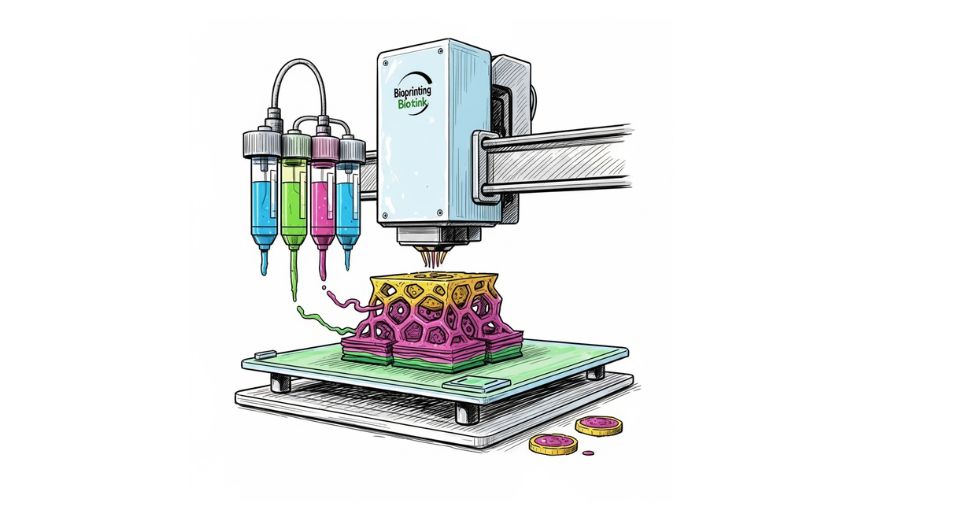
Jun 03, 2025

The Global 3D Bioprinting Market by Metastat Insight is a look into the future of healthcare, providing access to leading-edge technology for transforming medicine and science. At the forefront of this transformation are 3D bioprinting, which transformed designing biological tissues and organs into constructing intricate structures from living cells. It's of such a kind to make it the biggest leap so far which forms as some steps really, but also has the potential to drastically alter the landscape in fields of regenerative medicine and drug testing along with tailor-made health care by way of personalization. Global 3D Bioprinting market is expected to hit $1,369.76 million in 2025 with CAGR of 12.7% from 2025 to 2032
The technology uses a sophisticated printing process combined with living cells from bottom to top for an intricate buildup of 3D biological structures similar with the properties of human tissue using 3D bioprinting methods. In general terms, it's the bioinks: one living-cell-based and another biomaterials-based-and specialized printers for printing in a very highly defined manner and depositing material towards forming functional tissues. A demonstration of exactly what this method allows is high-precision tissue and organ printing. The technology can potentially shatter some of medicine's long-standing hurdles. One of the most astonishing aspects of 3D bioprinting is that it can speed drug development at a phenomenal pace. Conventionally, drug testing relied on animal models and human trials-the both of which take considerable time, are expensive, and are ethically complicated.
There is a more effective and ethical solution by providing the potential of creating models of human tissue that will be utilized to test novel drugs. These models reflect a better insight into how drugs are going to interact with cells in humans, which enhances the possibilities for finding effective therapies while minimizing dependence on animal testing. Aside from its potential effect on drug development, 3D bioprinting has tremendous potential in organ transplantation. With the growing shortage of donor organs available globally, interest has been building in the possibility of printing functional organs for transplantation. While we have only just begun with this type of technology, already very important developments have been witnessed in creating simpler tissue such as skin, cartilage, and blood vessels through 3D printing methods.
With the advancement of the technology, so is the potential of creating whole functioning organs for transplantation. This opens doors to new hope for patients in serious need of life-saving organ transplant. The Global 3D Bioprinting Market will significantly influence the area of personalized medicine. This type of medical care deals with the delivery of tailor-made treatments suited to a particular patient, depending on his genetic makeup and other health-related factors. One can actually develop organ and tissue models for each patient specifically by making use of 3D bioprinting, thus providing highly personalized treatment. These models are to be applied in order to model the way a patient's body is going to respond to some particular treatment, so the physicians can choose the optimal course of action with a minimum of side effects.
Despite its promise, the market for 3D bioprinting confronts several challenges which have to be overcome before the technology can realize its potential. One such significant hindrance is the access to more sophisticated bioinks that have the ability to replicate the characteristics of various categories of human tissues. The creation of bioinks that are stable and biocompatible and enable the growth and operation of living cells is a critical research area in this regard. In addition, the complexity that is needed in order to print more advanced tissues and organs requires the overcoming of technical restraints, among which the enhancement of resolutions in printers and the development of more advanced printing techniques are of particular importance. Another important challenge will be the regulatory landscape of 3D bio printed products. The advanced the technology, the more there will be a requirement for guidelines and standards to offer safety and efficacy to tissues and organs bioprinted. Regulatory agencies will therefore be very much responsible in laying down the legal and ethical boundary of use of 3D bioprinting in medicine for its safe and responsible application.
Even though the future of the 3D bioprinting market is going to be challenging, yet still the future is promising continuous research and development towards the technology. More maturity in the technology is going to bring more sensational breakthroughs in functional tissue and organ production and even personalized medicine solutions to come. The use of 3D bioprinting is as broad as possible with the scope, ranging from tissue repair to drug screening, all through organ transplant and much, much more. The trend of the market presently is bound to increase as scientists as well as medical professionals seek to collaborate with industry giants to introduce such break-throughs. This global 3D Bioprinting Market of Metastat Insight shows a new era in medical technology that will revolutionize the treatment of medicine and health care.
Through this, 3D bioprinting can revolutionize regenerative medicine, drug development, and personalized health care in an unimaginable way by providing an opportunity to create tissues and organs with precision. There is still much to be achieved; still, its ongoing development guarantees that such a possibility where tissue and organ building will no longer be an unrealistic fantasy, but one sure to revolutionize the lives of millions of people across the globe.
Drop us an email at:
Call us on:
+1 214 613 5758
+91 73850 57479